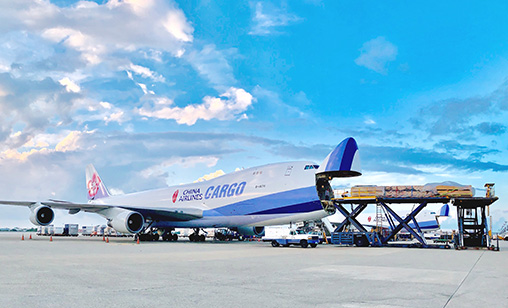Air Cargo
Hong Kong/China air cargo declines in U.S. tariff limbo
Air cargo markets continue to gain ground, but there are signs trade routes are undergoing a historical shift in the face of global economic and geopolitical issues. Amid the uncertainty of U.S. tariff threats Asian exporters appear to be looking for new markets for their goods. Associate editor and chief correspondent, Tom Ballantyne, reports.
June 1st 2025
Association of Asia Pacific Airlines (AAPA) cargo statistics for May show air cargo markets posted more gains compared with the previous month but growth had moderated, an outcome of weaker export activity. Read More »
There are clouds on the region’s air freight horizon. Recent figures from Amsterdam-based WorldACD Market Data reveal that after rebounding in the second half of May, air cargo tonnages from China and Hong Kong to the U.S. declined 10% week-on-week in the opening week of June, 19% below the equivalent week in 2024.
Additionally, spot rates for cargo declined 5% week-by-week and 17% year-on-year. “This significant decrease in tonnages and rates [between China/Hong Kong and the U.S.] followed a short recovery in the previous three weeks after the latest U.S. import tariffs on Chinese manufactured goods were paused.
 |
With the pause in place for now, the current slump in the China/Hong Kong to U.S. market suggests the May rebound was a temporary rather than a structural recovery and is linked to delayed volumes “catching up” after the suspension of the punishingly high tariffs imposed in April,” WorldACD wrote.
One of the biggest shifts in the sector’s pricing was a 12% fall in spot rates from Hong Kong to the U.S. This market has been heavily reliant on e-commerce traffic in recent years and has been particularly affected by the recent changes to U.S. ‘de minimis’ rules; the removal of tax-free exemptions for low value shipments from China and Hong Kong. As a result, much higher import charges and processing costs have been applied to this sector of e-commerce cargo since the beginning of May.
Analysts report the China to U.S. volume slump is not the end of the story. Although the U.S. tariff pause is continuing, uncertainty and the potential for reimposition of the tariffs inevitably influences air freight flows.
To address the shortfall, exporters across the region, from Taiwan and Japan to Vietnam and South Korea are seeking new, non-U.S. markets for their goods.
The International Air Transport Association (IATA) predicts a global slowdown in cargo growth in 2025, primarily based on lower GDP growth from trade dampening protectionist measures that include tariffs.
 |
| “Air cargo demand globally grew 2.2% in May. That is encouraging news but a 10.7% drop in traffic on the Asia-to North America trade lane illustrated the dampening effect of shifting U.S. trade policies. Even if these policies evolve, already we can see the air cargo sector’s well tested resilience helping shippers to accommodate supply chain needs to flexibly hold back, re-route or accelerate deliveries.” |
| Willie Walsh IATA director general |
“Air cargo growth is expected to slow to 0.7% in 2025 from 11.3% in 2024. Cargo yield also is expected to reduce by 5.2%, reflecting a combination of slower demand growth and lower oil prices. But although significant uncertainty remains about how trade tensions will evolve over the year, as of April cargo demand was holding up well with a 5.8% year-on-year increase,” IATA said.
AAPA director general, Subhas Menon, said international freight demand registered 4.5% growth in May, supported by front-loading of shipments and rerouting of goods to other gateways amidst mounting economic headwinds.
Improved air connectivity is predicted to cater for passenger travel demand, he said but “nevertheless, Asia-Pacific carriers face an increasingly challenging operating environment, shaped by rising trade and geopolitical tensions, persistent supply chain constraints and more frequent overflight diversions due to airspace closures in conflict zones.
“In addition, fuel prices may remain volatile if the Middle East conflict prolongs. At the same time, air cargo markets are expected to come under pressure from weakening export orders, although shifts in trade routes could help mitigate some of the impact.”
The operating environment for air freight, complicated by geopolitical tensions and economic uncertainty are not the only issues that impact air cargo business.
Another factor WorldACD points out is a 3% drop in worldwide air cargo tonnages because of the recent number of major holidays worldwide, dragging down overall volumes by 1%.
There was a 6% WoW fall in ex-Southeast Asia, largely driven by Eid Al-Adha holidays (June 5-8), especially Malaysia (-14%) and Indonesia (-10%). Volumes ex-South Korea were lower by 6% because of the nation’s Memorial Day on June 6.
Following increases in May, Mainland origin tonnages to Europe decreased 5% WoW. Hong Kong-Europe tonnages were better by 2% WoW. But volumes to Europe were significantly down at 16% WoW from South Korea (linked to the June 6 Memorial Day) and Malaysia (26%) and Indonesia (24%), respectively, during Eid.
Other factors in the general worldwide tonnage decline in the month included falling outbound tonnages from Europe (-4%) and the Middle East and South Asia (-8%). Europe traffic was impacted by the ‘Pentecost’ holiday (June 8-June 9) and once again Eid was a major factor in the 26% fall in MESA volumes.
These tonnage declines were only partly offset by an 8% WoW rebound in ex-North America traffic from the depleted levels of the U.S. Memorial Day holiday on May 26.
Anna Travers says:
September 17th 2025 03:17am